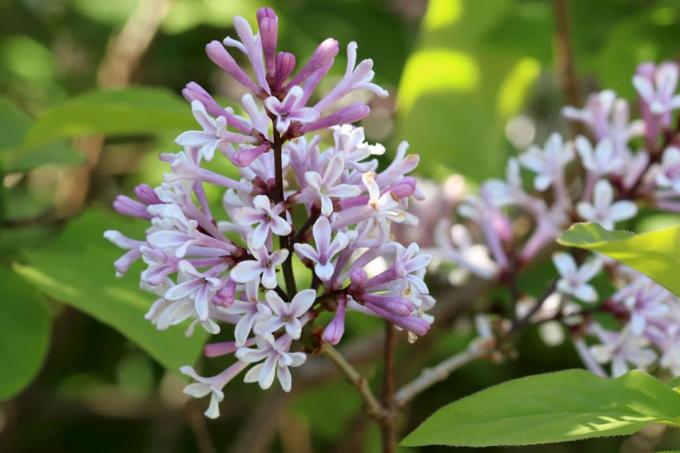
table of contents
- Lilacs in the garden
- Planting lilacs
- Plant bare-rooted lilacs
- Plant container goods
- Transplant lilacs
- frequently asked Questions
Whether in brilliant white, delicate pink or purple, lilac is one of the most popular flowering trees in the garden. What should be considered when planting and when is the right time?
In a nutshell
- 30 different types of lilac are known
- common in Europe and Asia
- popular source of nectar for butterflies
- best planting time for bare-root crops in autumn
- Container goods can be planted all year round
Lilacs in the garden
Because of old-fashioned! Lilac (Syringa vulgaris) has long been high on the popularity list again. No wonder, after all, it convinces with its abundance of flowers and enchanting fragrance. Many new cultivars are available, which fit in the cottage garden as well as in modern gardens.
Recommended varieties are
- Chinese lilac (Syringa chinensis)
- Autumn lilac (Syringa microphylla)
- Cut-leaf lilac (Syringa laciniata)
- Hungarian lilac (Syringa josikaea)
- Dwarf Lilac (Syringa meyeri)

Planting lilacs
The best time to plant lilac bushes is autumn. Suitable locations for the flowering shrub are:
- sunny
- not too wet
- calcareous
- permeable
Note: Keep in mind that lilacs can grow up to seven meters tall, depending on the variety. Therefore, choose pretty species of dwarf lilac for the allotment garden. These reach a height of two meters and are ideal for smaller plots.
Plant bare-rooted lilacs
Most bare-root lilacs are planted. This is cheaper than container goods. The best time to plant is in autumn between October and March.
Instructions:
- Place the wood in a container with water an hour before planting.
- Dig a planting hole. It should be about twice the size of the root ball.
- Cut back the root tips and shorten the shoots above the bud base. Use sharp, clean scissors.
- Mix the excavated soil with compost.
- Put potsherds or gravel into the planting hole as drainage.
- Put the bush in. Make sure that the refining point is above the surface of the earth. Under no circumstances should it be covered with earth.
- Fill the planting hole with the soil mixture.
- Water the lilac well.

Plant container goods
Container goods do not need to be pruned before planting. It can therefore be planted all year round.
Instructions:
- Take the wood from the container. Put it in a vessel with water until no more air bubbles rise.
- Dig a planting hole. It should be about twice the size of the root ball.
- Mix the excavated soil with compost.
- Put potsherds or gravel into the planting hole as drainage.
- Insert the lilac bush just as deep as it was in the container before.
- Fill the planting hole with the soil mixture and tread the area around the root.
- Water the lilac well.
Transplant lilacs
Usually lilac bushes stay in one place. Should it still be necessary Transplant lilacs, choose a date in the fall. Extensive pruning is carried out before transplanting. Even the roots have already reached a considerable size, depending on their age. Dig up the wood generously. Then put it in its new location with a drainage made of pottery shards or gravel. After transplanting, water the lilacs extensively.

Note: Dwarf lilac species are excellent for tub culture. Fill the pot with potsherds or gravel as a drainage layer. This prevents waterlogging, one of the greatest dangers for the flowering shrub.
frequently asked Questions
Lilac bushes are very easy to care for once they have grown. They do not need to be watered or fertilized. They even tolerate dry summers well. Provide the flowering wood with a little compost in the spring, then the blossoms are assured.
Lilac is a sun worshiper. In shady places, the flowers are less pronounced.
Occasionally, lilacs may not flower after being planted or transplanted. Give him some time. The flowering plant usually recovers after one to two years.
Lilac (Syringa vulgaris) and summer or Butterfly lilacs (Buddleja davidii) are not related to each other. Butterfly lilac is usually offered as container goods. It can be planted all year round. Its location requirements are similar to those of the lilac. He also prefers a sunny, dry location in the garden.



